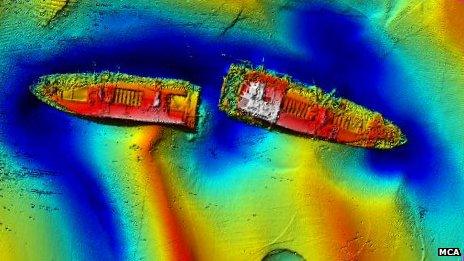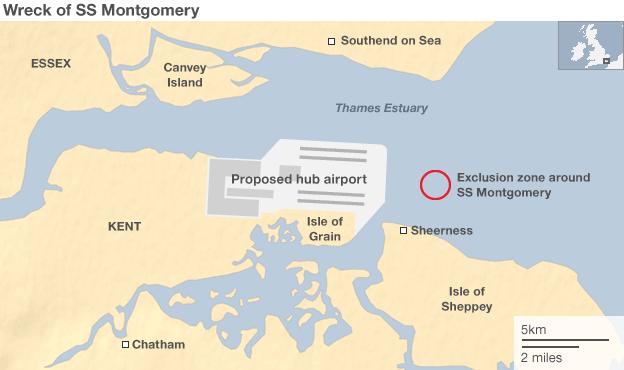Does WWII wreck SS Richard Montgomery threaten Thames airport?
- Published

The SS Richard Montgomery was anchored in Sheerness when it grounded and broke up in 1944 and now lies under the water on a sandbank (pictured bottom right)
As the deadline looms for submissions to a review of Britain's future aviation policy, does a wartime wreck still packed with explosives prove the biggest threat to those wanting to build a super-airport in the Thames Estuary?
Three masts visible above the waterline signal its menacing presence - a shipwreck packed with wartime bombs resting on a sandbank in a busy shipping route.
The SS Richard Montgomery, a cargo ship built in Florida to carry vital supplies for the war effort, was anchored in Sheerness, Kent, when it grounded and broke up in 1944.
For almost 70 years it has rested on a sandbank with 1,400 tonnes of explosives on board, monitored 24-hours a day by port authorities and protected by a 500m (1640ft) exclusion zone.
Successive governments have wrestled with the problem of what to do with the wreck, which lies in 50ft (15m) of shallow water about 1.2 miles (2km) off the coast.
Floating airport
But the question of its safety has been brought in to sharp relief by the debate over the future of Britain's aviation policy - and the possible construction, about 1.5 miles (2.4km) away, of an airport handling almost triple the number of passengers as Heathrow.
The Maritime and Coastguard Agency (MCA) insists the wreck is being safely managed and the chance of an explosion is remote, but others have concerns that further deterioration, a collision with another vessel, or a terrorist attack could detonate its cargo.
A commission chaired by ex-Financial Services Authority (FSA) boss Sir Howard Davies is to consider a number of options to expand airport capacity in the South East, external and report back in 2015.
There have been three different plans put forward recently to build airports in the Thames Estuary, including a floating airport designed by architects Gensler.
.jpg)
The masts of the wrecked ship are visible from the shore
.jpg)
The SS Richard Montgomery was anchored in Sheerness when it grounded and broke up in 1944

Sonar images show the wreck in two pieces on a sandbank about 1.2 miles (2km) off the coast of Sheerness

The wreck is monitored 24-hours a day by port authorities and protected by a 500m (1640ft) exclusion zone.
Another plan is known as Boris Island after it was backed by the London mayor, and there are proposals for a hub airport on the Isle of Grain, designed by architect Sir Norman Foster.
Other ideas include the expansion of Gatwick, Heathrow or Stansted.
Sir Norman's blueprint for a £50bn four-runway airport on the Isle of Grain - at the easternmost point of the Hoo peninsula - has been variously described as bold, visionary and "absolutely nuts".
One of the most influential of modern architects, Sir Norman designed the terminal building at Stansted Airport, as well as Chek Lap Kok in Hong Kong, one of the world's largest airports.
Now he wants to take his expertise to the Thames Estuary with plans for four runways and the capability to handle 150 million passengers a year. Britain's largest airport, Heathrow, handles 60 million.
Sceptics point out that air traffic would approach from the north-east over the water - close to the Montgomery's resting place. The question asked by some is who would risk building the world's largest airport near a ticking time-bomb under the waves?
Kielce explosion
Currently, the wreck is managed and monitored by the coastguard agency on behalf of the Department for Transport (DfT).
It is one of only two vessels in UK waters designated as dangerous under section two of the Protection of Wrecks Act 1973, external. The other, the SS Castilian, which sank off Anglesey, Wales, in 1943, is also closely monitored.
It was carrying munitions to Lisbon, Portugal, when it struck East Platters Rocks and sank.
The coastguard agency uses sonar equipment to carry out annual surveys of the Montgomery, and monitors its exclusion zone 24 hours a day.
Following a structural survey in 2009, the MCA found that although the hull appeared to be "reasonably stable", a crack in one of the vessel's holds was "of concern".
The latest survey reported: "The majority of the wreck's structure appears to be stable. Little sign of deterioration since 2009 was evident and only small changes were noted in the wreck's structure and the surrounding seabed."
The agency believes the risk of moving the wreck, or attempting to remove the cargo, would increase the likelihood of an explosion.
It has pursued a policy of non-interference since a botched attempt to remove the munitions from a Polish ship that sank in 1944.
In 1967, the Folkestone Salvage Company was attempting to clear the Kielce when a large explosion ripped through the vessel.
The seismic effects of the blast were recorded about 5,000 miles (8,000km) away. In Folkestone, slates were dislodged and windows smashed, but there were no injuries.
Receiver of wreck Alison Kentuck said it was the general consensus that the munitions were "stable if left undisturbed".
Though the management of the wreck was under "constant review", the current strategy was considered "the best and safest", she added.

Others disagree. Local historian Colin Harvey's film about the wreck - A Disaster Waiting to Happen - is occasionally screened to residents on the Isle of Sheppey.
He fears its cluster bombs could fall through the corroding upper deck and detonate the munitions below, leading to a blast that would "level buildings, burst eardrums and shatter windows".
Mr Harvey said the blast could cause a tidal wave, flooding parts of the Isle of Sheppey, the Isle of Grain, perhaps even Canvey Island and Southend.
In August 2004, a report in the New Scientist magazine said if the ship exploded it would be one of the biggest non-nuclear blasts ever seen and devastate the port of Sheerness, causing up to £1bn of damage.
Mr Harvey added: "The population has lived with the wreck all these years and now (the problem) is brought into focus because of the airport.
"The thinking is that if they build the airport then maybe they will deal with the wreck. It's going to have to be dealt with and the sooner the better."
There are also question marks over the safety of the exclusion zone.
One documentary filmmaker, who did not want to be named, told the BBC he was able to film the wreck from a rubber raft anchored to the outer warning buoy of the zone.
"Neither the coastguard or police paid us any attention on the way out, while we were there, or on returning to shore," he said.
Responding to the claims, a spokesman for the MCA said: "If people break the exclusion zone, and they are caught doing so, then they would be taken to task. But if he's not gone into the exclusion zone, then he's not done anything wrong."
But what can be done to remove the threat posed by the wreck? According to experts, there are two possible options; carry out a controlled explosion or remove the munitions.
Mark Hoddinot, general manager of the International Salvage Union, said the wreck could be moved if the will and financial muscle were there.
'Unknown territory'
"There are a lot of legacy wrecks, hundreds of them, and the issue with most of them is who is going to pay to have them removed," he said.
"The majority of the cost, if not all, is going to be met by taxpayers because the insurers have long since disappeared.
"The main issue is the ammunition but in this technological age, there would be a way to remove that safely. The work itself does not present any major technological challenges, it would be relatively straightforward."
Mr Hoddinot said ships sunk in the Iran-Iraq war during the 1980s were being safely removed from the Persian Gulf, despite having deteriorating explosives on board.
Ian Biles, managing director of marine surveying company Maritime Services International, said the key question was whether the munitions had degraded to such an extent that they were safe to move.
"There's always been this debate 'why not just blow it up and see what happens' because the water would act as a denting mechanism.
"But I can understand why they have adopted the approach they have to leave it alone. It's unknown territory."
The New Scientist report in 2004 also suggested one option would be to encase the wreck in tonnes of sand, deadening any potential explosion.
A Fosters and Partners spokeswoman said the firm had done a thorough study of the wreck.
"We have talked to bomb disposal experts and other experts about the SS Montgomery and its munitions cargo," she said.
"These studies continue and all possibilities for the future of the ship will be explored."
Last year, a spokesman for Boris Johnson said: "Clearly the wreck of the SS Montgomery would need to be considered however some of Britain's finest engineers have already closely studied the area and concluded it would not prevent construction of an airport."
The Airports Commission will make its final report to the government in the summer of 2015.
- Published5 June 2013
- Published29 May 2013
- Published10 May 2013
- Published5 May 2013
- Published2 November 2012
- Published11 February 2013
- Published19 November 2012
- Published12 September 2012
- Published26 November 2012
- Published24 December 2012
- Published2 November 2011
- Published29 November 2011
- Published7 December 2011
- Published6 September 2011